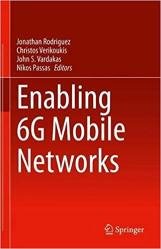Enabling 6G Mobile Networks
- Добавил: literator
- Дата: 6-11-2021, 18:41
- Комментариев: 0
 Название: Enabling 6G Mobile Networks
Название: Enabling 6G Mobile NetworksАвтор: Jonathan Rodriguez, Christos Verikoukis
Издательство: Springer
Год: 2022
Страниц: 594
Язык: английский
Формат: pdf (true)
Размер: 17.3 MB
As Fifth Generation (5G) mobile networks are being rolled out, the telecom industry and academia are now coordinating the 6G research effort towards defining the requirements and use cases for Beyond 5G (B5G) or so-called Sixth Generation (6G) mobile networks. 6G will be more encompassing in terms of communication requirements in contrast to its predecessor, being more society centric in terms of requirements; in addition to the vertical market requirement, it is widely accepted that the 6G drive will be influenced by global policy on sustainability goals for an ageing and growing population, as well as addressing societal challenges. The aim is to deliver a 6G architecture that promotes digital inclusion and accessibility, as well as unlocking economic value and opportunities in rural communities.
This book edition aims to address the ongoing international effort towards the 6G paradigm, through the lens of international European training networks and early-stage researchers. The authors provide an overview on the drive towards 6G by identifying key enabling technologies and system requirements and highlighting developments in the global B5G/6G arena. This provides the impetus for the subsequent chapters that target enabling 6G technologies, as well as advanced 5G technologies, that may become part of future standards.
This book tackles the 6G odyssey, providing a concerted technology roadmap towards the 6G vision focused on the interoperability between the wireless and optical domain, including the benefits that are introduced through virtualization and software defined radio. The authors aim to be at the forefront of beyond 5G technologies by reflecting the integrated works of several major European collaborative projects (H2020-ETN-SECRET, 5GSTEPFWD, and SPOTLIGHT). The book is structured so as to provide insights towards the 6G horizon, reporting on the most recent developments on the international 6G research effort.
The first roll-out of 5G (2019-2020) is targeting sub 6 GHz small cells based on a Cloud Radio Access Network (C-RAN) architecture. However, subsequent roll-outs will deploy the full 5G vision that addresses the hyperdense deployment of small cells based on millimeter wave frequencies, where larger swathes of spectrum are available. This will be coupled with multiple antenna technology deployed on a massive scale that in synergy will have a multiplier effect on user peak data rates and cell capacity, enabling the 5G system to fulfil the ambitious performance indicators specified by 3GPP.
However, going beyond 5G systems, the so-called B5G paradigm is pushing back further the boundaries on communication systems in a bid to introduce tactile internet applications that combine ultralow latency with extremely high availability, reliability, and security. Speed is also a key design requirement in 6G systems. Whereas 4G was about megabit connectivity, 5G pushed the gigabit barrier, and 6G is eventually expecting to deliver theoretical terabit speeds. To entertain B5G systems will undoubtedly rely on several enabling technologies that already have their footprints engraved within now legacy 5G systems, that includes softwarization, optical networking, and high-frequency (above 6GHz) communications.
The authors address a variety of telecom stakeholders, which includes practicing engineers on the field developing commercial solutions for 5G and beyond products; postgraduate researchers that require a basis on which to build their research by highlighting the current challenges on radio, optical and cloud-based networking for ultra-dense networks, including novel approaches; and project managers that could use the principles and applications for shaping new research proposals on this highly dynamic field.
- Provides a concerted technology roadmap towards the 6G vision focused on the interoperability between the wireless and optical domain;
- Discusses the benefits of 6G, introduced through virtualization and software defined radio;
- Includes concepts as well as applications to provide a base for the reader to acquire new knowledge on optical, wireless, and cloud computing.
Скачать Enabling 6G Mobile Networks
[related-news] [/related-news]
Внимание
Уважаемый посетитель, Вы зашли на сайт как незарегистрированный пользователь.
Мы рекомендуем Вам зарегистрироваться либо войти на сайт под своим именем.
Уважаемый посетитель, Вы зашли на сайт как незарегистрированный пользователь.
Мы рекомендуем Вам зарегистрироваться либо войти на сайт под своим именем.
